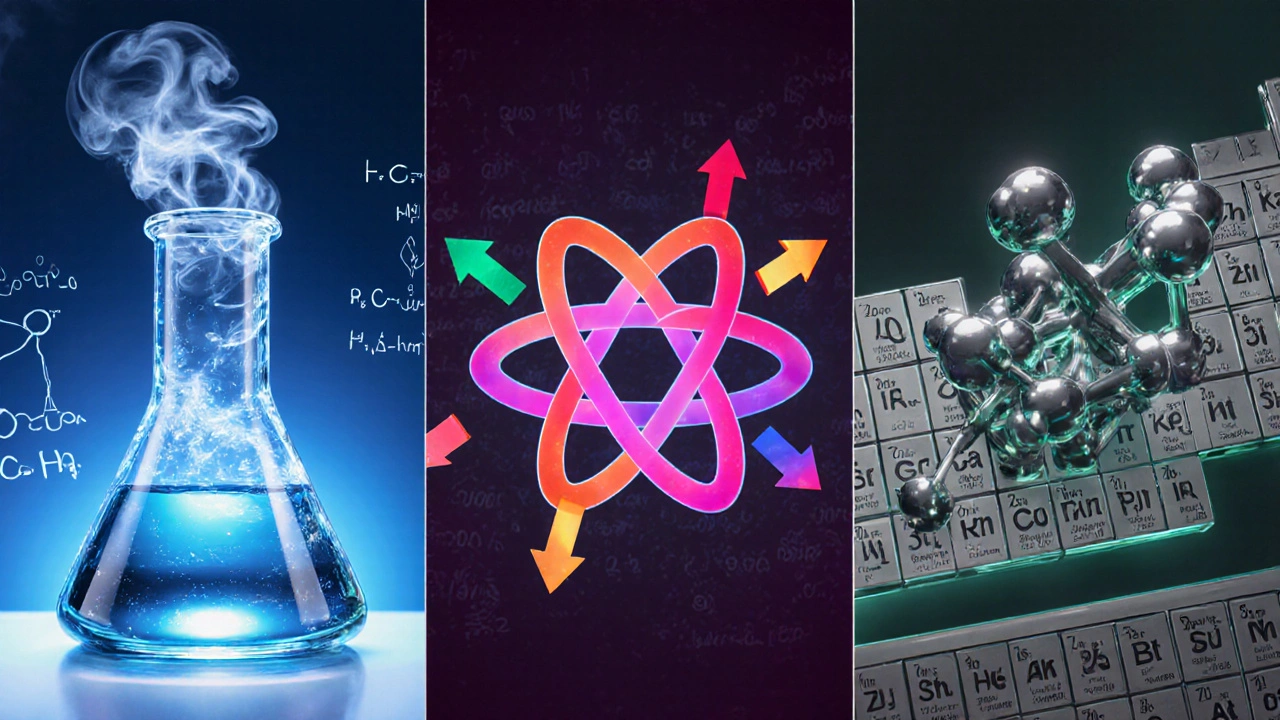JEE Chemistry Difficulty Estimator
Personal Assessment
Rate your strengths in these areas (1-10, where 10 = strongest)
How It Works
Your inputs are weighted against JEE exam factors to calculate chapter difficulty:
- Weightage Higher weight = more points but higher difficulty
- Conceptual Load Topics requiring multiple concepts simultaneously
- Numerical Intensity Sections with complex calculations
Personalized Difficulty Assessment
When you stare at the JEE Chemistry syllabus, one question keeps popping up: toughest chapter in chemistry for JEE. Knowing which chapters drain the most time and points lets you focus your effort where it matters most.
Understanding the JEE Chemistry Landscape
JEE Chemistry is a comprehensive test of three sub‑domains - Physical, Organic, and Inorganic Chemistry - each contributing roughly one‑third to the total chemistry score. The exam examines not just factual recall but problem‑solving speed and conceptual depth.
Below is a quick snapshot of the three pillars:
- Physical Chemistry: thermodynamics, kinetics, electrochemistry, surface chemistry.
- Organic Chemistry: reaction mechanisms, stereochemistry, functional group transformations.
- Inorganic Chemistry: periodic trends, coordination compounds, p‑block elements.
Each pillar houses a few chapters that consistently appear as low‑score zones for aspirants.
What Makes a Chapter ‘Tough’?
We judge difficulty on three practical axes:
- Weightage vs. Conceptual Load - Chapters that carry high marks but require multiple concepts simultaneously (e.g., thermodynamics combined with equilibrium).
- Numerical Intensity - Sections packed with derivations, multi‑step calculations, or unfamiliar formulas (e.g., electrochemistry).
- Application Diversity - Topics that appear in both theory and problem‑solving questions across years, leaving little room for lucky guessing.
Based on recent JEE papers (2022‑2024) and coaching feedback, the following chapters tick all three boxes.
List of the Toughest Chapters
Below you’ll find the chapters that most students flag as “hard”. Each entry includes why it’s challenging and a quick tip to tame it.
- Electrochemistry (Physical) - Involves Nernst equation, electrode potentials, and Gibbs free energy relations. The math blends logarithms with sign conventions, which many miss. Tip: Memorize the sign chart once and practice conversion between ΔG, E°, and K.
- Chemical Kinetics (Physical) - Rate laws, order of reaction, and the Arrhenius equation appear together. Students often confuse overall order with individual steps. Tip: Derive rate equations from mechanisms; the derivation itself reinforces the concept.
- Thermodynamics (Physical) - Entropy, enthalpy, and free energy intertwine across multiple topics. The tricky part is applying Hess’s law and calculating ΔS for gas reactions. Tip: Create a single-page summary linking each formula to its physical meaning.
- Organic Reaction Mechanisms (Organic) - Multi‑step pathways, carbocation stability, and stereochemical outcomes demand a clear mental map. Tip: Sketch mechanisms repeatedly; color‑code electron flow arrows for visual memory.
- Coordination Chemistry (Inorganic) - Crystal field theory, ligand field splitting, and magnetic moments are dense and calculation‑heavy. Tip: Use the 3‑step rule (oxidation state → geometry → magnetic moment) to quickly narrow possibilities.
- Equilibrium in Solutions (Physical) - Kc, Kp, and solubility product calculations are interwoven, often in a single problem. Tip: Practice the conversion between concentration and pressure units; it clears most surprises.
- Organic Stereochemistry (Organic) - Enantiomers, diastereomers, and optical activity involve spatial reasoning. Tip: Build molecular models with kits or software; tactile interaction fixes the 3‑D view.

Comparison Table - Toughness Score, Weightage & Key Pitfalls
| Chapter | Typical Weightage (%) | Difficulty Score (1‑5) | Common Pitfall |
|---|---|---|---|
| Electrochemistry | 6‑8 | 5 | Sign errors in Nernst equation |
| Chemical Kinetics | 5‑7 | 4 | Mixing overall order with step order |
| Thermodynamics | 8‑10 | 5 | Mis‑applying ΔS for gases |
| Organic Reaction Mechanisms | 7‑9 | 4 | Skipping intermediate steps |
| Coordination Chemistry | 4‑6 | 4 | Incorrect crystal field splitting values |
| Equilibrium in Solutions | 6‑8 | 4 | Wrong Kc ↔ Kp conversion |
| Organic Stereochemistry | 5‑7 | 3 | Confusing R/S with optical activity |
Strategic Study Blueprint
Cracking these chapters isn’t about endless hours; it’s about smart cycles.
- First pass - Conceptual clarity: Read NCERT explanations, watch a 15‑minute video, then write key formulas in your own words.
- Second pass - Targeted practice: Solve 5‑7 JEE‑style questions that combine the chapter with another sub‑domain (e.g., thermodynamics + equilibrium).
- Third pass - Speed drills: Time‑boxed numerical sets (10min for 5 problems). The goal is to finish each problem within 2minutes without losing accuracy.
- Revision loop: Every two weeks, revisit the chapter’s cheat‑sheet and redo a mixed set of 10 questions.
Remember, the toughest chapters also give the highest return when mastered, because they appear repeatedly in both SectionII (multiple‑choice) and SectionIII (numerical answer) papers.
Quick Cheat‑Sheet - Must‑Know Items
- Electrochemistry: Nernst equation sign chart, ΔG=‑nFE°, standard electrode potentials list.
- Kinetics: Rate law, half‑life formulas, Arrhenius plot slope‑intercept method.
- Thermodynamics: ΔG=ΔH‑TΔS, Gibbs‑Helmholtz, entropy change for gases (ΔS=nRln(V₂/V₁)).
- Organic mechanisms: Identify nucleophile/electrophile, keep track of carbocation stability (3°>2°>1°>methyl).
- Coordination chemistry: Crystal field splitting Δ₀, high‑spin vs low‑spin, magnetic moment μ=√(n(n+2)).
- Equilibrium: Kc ↔ Kp conversion (Kp=Kc(RT)^Δn), solubility product (Ksp) rules.
- Stereochemistry: Assign R/S using Cahn‑Ingold‑Prelog, recognize meso compounds.
Frequently Asked Questions
Which chemistry chapter carries the highest weightage in JEE?
Physical Chemistry topics like Thermodynamics and Electrochemistry together account for about 20‑25% of the total chemistry marks, making them the most heavily weighted.
How many JEE problems typically involve Electrochemistry?
In the last three years, Electrochemistry appeared in 4‑6 questions per paper, often split between theory and numerical answer types.
Is it better to learn Organic mechanisms before practicing problems?
Yes. Understanding the step‑by‑step flow of electrons prevents common mistakes when you later tackle multi‑step JEE problems.
What resources are most useful for mastering Coordination Chemistry?
NCERT + a standard JEE guide (e.g., "Physical Chemistry" by O.P. Tandon) plus a quick‑reference table of crystal field splitting energies works best.
How often should I revisit tough chapters during revision?
Aim for a bi‑weekly cycle: review concepts, redo a mixed problem set, and update your cheat‑sheet. This reinforces long‑term memory without burning out.
By pinpointing the toughest chemistry chapters and applying a focused study plan, you turn what feels like a roadblock into a scoring advantage. Gear up, practice smart, and let those challenging topics work for you on the JEE day.
